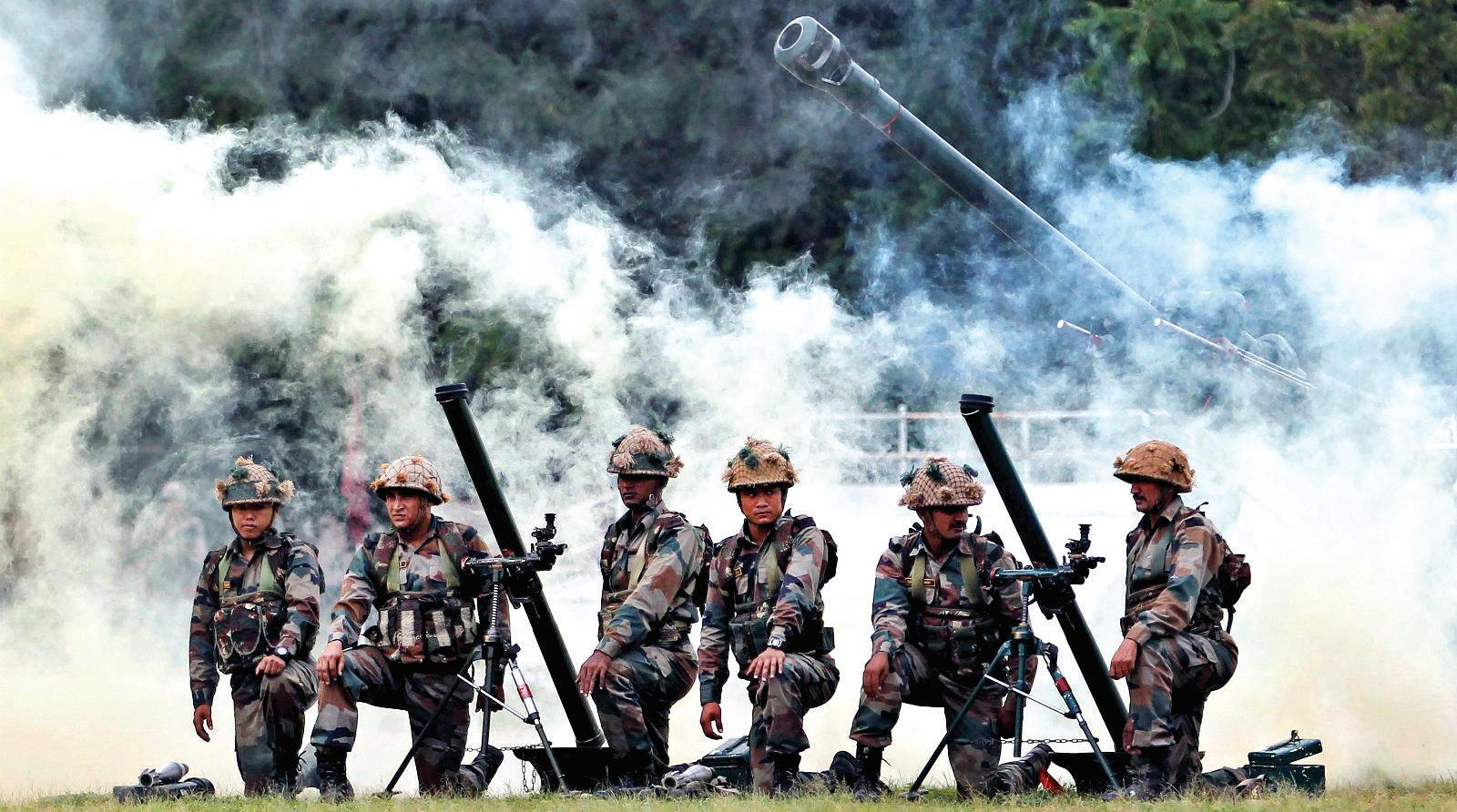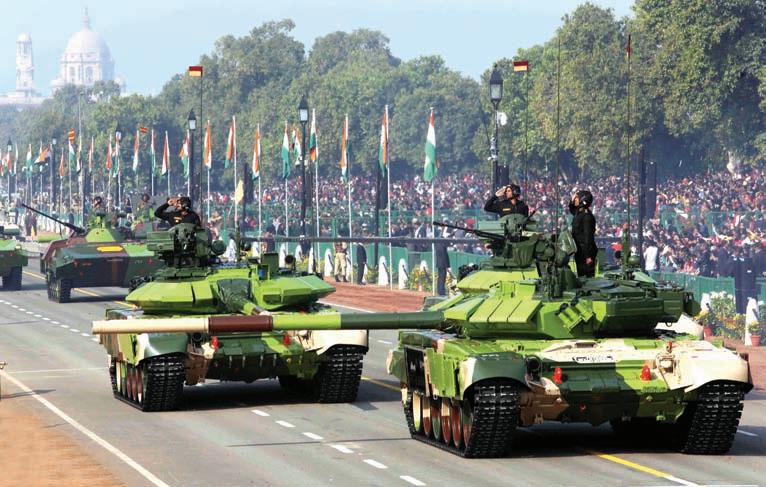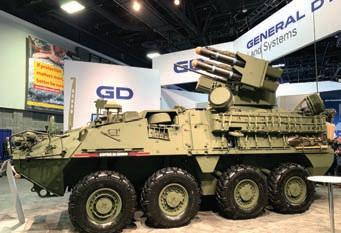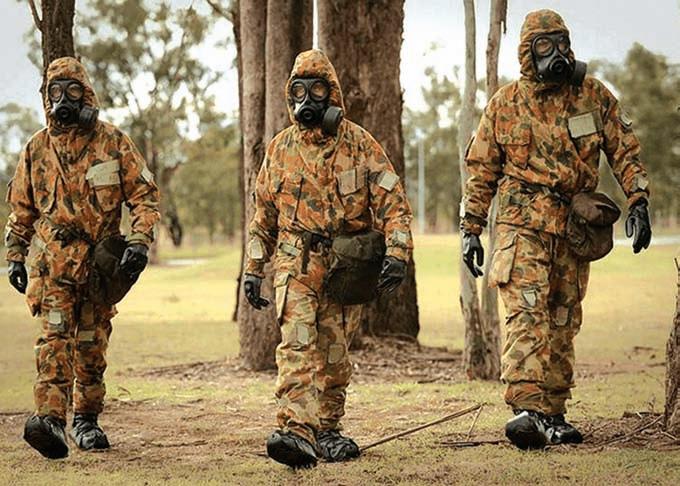
9 minute read
Indian Defence: Trends and Trajectory
MARKET WATCH INDIAN DEFENCE: TRENDS AND
TRAJECTORY With a rapid change in geopolitical scenario, Indian defence sector though with constraint budget playing a balancing act as the government is constantly striving to formulate policies to empower the sector including MSMEs in order to develop By DR SURABHI AGARWAL a robust ecosystem for indigenous defence production
Advertisement
Indian Army jawans laced with
technological equipment (File photo)
T
oday’s direct defence and critical security challenges in operating environment face tremendous and multifarious challenges related to security, henceforth it contests the dotted lines of integrated capabilities haloed with entrenched assumptions in ordinary citizens minds. War fighting capabilities highlights the increasing new meaning of the defence future, where procurement reflects a negative wave but will uphold large market for survivors only.
Enablement of generating a million new vistas of defence jobs can be sorted through procurement models exclusively as traditional defence and military capabilities require to now pose as acclimatised troops equipped with transformed military warfare maps. The use of term ‘surgical strikes’ here is both thrilling as well as live example which would be required more in military dealings. The adoption process of 360-degree aggressive ways of combatants in terms of strategic sourcing, surveillance, unmanned vehicles, automation intelligence, and reconnaissance spend analysis would introduce the phenomenal situational awareness in defence front.
Though devastating disruptions in production-consumption cycle adversely affected GDP of our economy by confiscating 6.3 per cent pull-off still the second half of the fiscal year would see rebounding
effects – as sourced from IHS Markit forecast. The GDP growth estimates are terrible after India entered the lockdown phase ranging between 2.1 per cent to 3.5 per cent.
Till July this year foreign direct Investment already witnessed US$17 billion by some huge names of global technology firm like Google, Amazon, Facebook and Foxconn which need no introduction. Next 10 years would witness a brilliant increment from US$1.6 trillion to US$3.2 trillion by urban middleclass huge power of consumption and expenditure backed by increased per capita income.
Defence is currently the “most fertile ground’’ as the phrase is self-explanatory. Government has invested on all fronts – manufacturing, procurement which can drive the key element of indigenisation thereby realising the dream of ‘Átmanirbhar Bharat’ (self-reliant India) in its true sense.
Defence Minister Rajnath Singh said, “Our aim is to make India selfreliant and a global manufacturing hub. The government is constantly striving to formulate policies to empower the private industry including MSMEs in order to develop the eco-system for indigenous defence production. The defence industry of India is a strategically important sector having huge potential for growth. It needs to be the catalyst for India’s economic growth and realisation of our global ambitions.”
PHENOMENAL SITUATIONAL COGNIZANCE
In this direction a whole list of embargoed defence items which were imported from outside until now were brainstormed, and inhouse available technologies/ capabilities can now be used to produce indigenously is a wakeup call to meet the next generation threats and vastly altered homeland and defence security ecosystem.
A turnover amounting to Rs 1.75 lakh crore has been perceived in defence manufacturing opening the new horizons in this niche field. Turnaround strategy adopted by Ministry of Defence (MOD) imparts powers to armed forces to process the need of equipment and weapons for meeting urgent operational requirements. By the year 2025, India aims to achieve a target goal in terms of turnover grabbing a whopping amount of US$25 billion and this include a portion of around US$5 billion of export in defence and aerospace goods. Like Information Technology, now India too will emerge as a hub of defence manufacturing as impetus on ‘indigenisation’ as this will be boosting the ecosystem of extensive ‘Defence Mission’ with a stipulated timeframe of 10 years.

BRIDGING THE GAP BETWEEN CIVILIANS AND ARMY
As a nation, generations should be made aware of the ‘Earned Freedom and its importance’. Trend of ‘only’ celebrating on the glorious days of Independence and Republic Days can be scrapped by introducing defence-based topics in school and college curriculums.
Promotion of developing technologies related to defence applications, production and research ecology modules can be drafted and included more in curriculum, this will also be leading to open more job vistas in both direct and indirect fields of defence and aerospace manufacturing.
Premium institutes of engineering and management across the country like IITs and IIMs present the best examples of how manufacturing development programmes ensuring required skill development can too be taught for capability building. Experienced and outstanding novels retiring every year can be involved in designing/ imparting the defence education curriculum.
FISCAL CHALLENGES IN DEFENCE-NOMICS
Our Country is undoubtedly struggling with worst economic DEFENCE IS CURRENTLY THE “MOST FERTILE GROUND’’ AS THE PHRASE IS SELFEXPLANATORY. GOVERNMENT HAS INVESTED ON ALL FRONTS – MANUFACTURING, PROCUREMENT WHICH CAN DRIVE THE KEY ELEMENT OF INDIGENISATION THEREBY REALISING THE DREAM OF ‘ÁTMANIRBHAR BHARAT’ (SELFRELIANT INDIA) IN ITS TRUE SENSE
Indian Army tanks during Republic Day parade (File photo)

“INDIAN MILITARY ALSO NEEDS TO CHANGE ITS MINDSET FROM A FRONTIER DEFENCE FORCE TO AN EXPEDITIONARY ONE CAPABLE OF PROJECTING POWER BEYOND THE SUBCONTINENT”
Ashley J. Tellis, Senior Fellow, Carnegie Endowment for International Peace
slowdown of the decade. Studies and analysis conducted by Moody’s understate that raising incomes and delivering on the terms of fiscal consolidation will be extremely tough and challenging. The revenue shortfall by June 2020 was Rs 6.62 lakh crore, fiscal deficit touched 83.2 per cent of the annual budget target in April-June quarter. Current financial year according to RBI will be a year of negative growth in terms of GDP.
Indian defence industries though is now under strict focus which include liberalisation of Foreign Direct Investment (FDI) policy as one of the most important features which raised the approval percentage to 74 from 49. This is surely going to streamline the domestic defence manufacturing in league with the prospective demands of our armed forces.
The recent ban on import of 101 items categorically listed by Ministry of Defence is a boosting and vibrant example where high technology weapon systems like light combat helicopters, transport aircraft, assault rifles, corvettes, artillery guns, sonar systems and radars as well as few other items will be indigenously produced.
DEFENCE-SMART GOVERNMENT
Regulatory defence policy restructuring is posing a huge challenge in the present scenario where a ratio of military spending and readiness can be in congruency with each other. Broadly worldwide a projection of around five per cent GDP contraction is estimated in the current year courtesy – steep decline in tax-revenues, staggering economies and indefinite negotiations in budgets.
Microeconomics of Defence Industry Needs Adoption of the Following Strategies: • Sustainabilityandadoption of acquisition strategies focussing actionable orientation is an important factor.
Understanding the intricate production buyer-supplier figure with predictable datadriven market sources is essential. Total cost reduction target paving strategies should be concentrated instead of
conquering profit margins. • Agilitytotheaddressmarket challenges would comprehend on adaptability, insight, and vision for the (breakthrough) output or final product, targeting customer focus and of course super empowered teams. • Completionoffullproduct cycles. • Survivaltovolatilityofdemand cycles thereby articulating exquisite challenges and face market pressures. • Provisionofcost-effective modularity always turns as a sure - shot striker. • Maintainingconcentrationon future technology like managing signature-strategic and Tactical
Bespoke Systems. • Challengingcontested environments.
India is growing as a power hub in defence capacity and a scholar named Ashley Tellis explicitly said, ‘’Indian military also needs to change its mindset from a frontier defence force to an expeditionary one capable of projecting power beyond the subcontinent”.
Pulwama and Balakot strikes manifested turning points bringing marvellous changes in the ways our defence used to work. Restructured strategies for frontier technologies and intervention for modernisation as well as preparation for future warfare have made a bright conjunction.
No wonder, termed as a hot cake, soaring defence budget indicates shift to a robust vision with allotted parameters both in terms of long -term defence planning as well as military procurement, which will definitely be able to prove its credibility, capacity and capability.
–The writer is a senior consultant having worked with IT and services industry. She is currently associated with Eirene Systems.
BEML EXPECTS TO RECEIVE ADDITIONAL ORDER WORTH RS 3,000 CRORE IN FY2020-21
US AWARDS $1.2 BILLION CONTRACT TO GENERAL DYNAMICS FOR 144 ARMY ANTI-AIRCRAFT STRIKERS
New Delhi. Defence PSU BEML Ltd expects to get additional orders valued at about Rs 3,000 crore by this financial year-end, its Chairman and Managing Director Deepak Kumar Hota said on October 1. The company has set an ambitious revenue target of Rs 4,000 crore in the current fiscal, up from the previous year’s figure of Rs 3,029 crore, despite the shortfall in the first quarter due to adverse impact of COVID-19 and lockdown. “We have orders on hand over Rs 10,000 crore and further orders of around Rs 3,000 crore are expected by FY 20 -21,” Hota said.

Washington. US Government on September 30 officially awarded General Dynamics a highly-anticipated contract to mass-produce the Interim Maneuver SHORAD vehicle. This variant of the 8×8 armored Stryker boasts an anti-aircraft radar, a 30mm auto cannon, and a missile launcher capable of launching Stingers and Hellfires. (A laser-armed Stryker variant is also in development). IM-SHORAD will replace the aging, unarmored, and undergunned Avenger, a Stinger-shooting variant of the Humvee, which has filled the Short-Range Air Defence role since the Cold War. Its Hellfires also give it significant capability to kill tanks.
IN A BIG TICKET ORDER, DEFENCE AND SECURITY SOLUTIONS PROVIDER OSHOCORP GLOBAL COMPLETES CBRN IPE SUPPLY TO BEL

ew Delhi. Chemical,
NBiological, Radiological and Nuclear (CBRN) are components of unconventional warfare and are also known as weapons of mass destruction (WMD). Defensive and Protective measures taken to mitigate CBRN warfare hazards need specially designed clothing & equipments.
In this backdrop, New Delhibased defence and security solutions provider OshoCorp Global Pvt Ltd has successfully completed one of its largest supply orders of Chemical, Biological, Radiological and Nuclear (CBRN) Individual Protection Equipments (IPE) sets to Defence PSU Bharat Electronics Limited (BEL) during the ongoing Covid-19 period.
Company Director Ashutosh Khate, speaking on the development, said OshoCorp’s CBRN IPE set consists of six major protection components giving security to our soldiers from head to toe. OshoCorp in the past also had successfully won and completed CBRN IPE sets and detection sensors orders from BEL and the other government agencies in the country, against the competition from domestic and global suppliers.
OshoCorp Global Pvt Ltd is an ISO 9001:2015 certified premier Indian defence company with NCAGE No. 1691Y (NATO) and is in receipt of multiple Defence Industrial License (DIL) from Government of India for manufacturing various restricted and sensitive defence systems.
OshoCorp as a reliable partner supports its client base with pioneering conceptual defence solutions to improve sustainability and self-reliance of the Indian Armed Forces.










